![]()
![]()
![]()
Use LEFT and RIGHT arrow keys to navigate between flashcards;
Use UP and DOWN arrow keys to flip the card;
H to show hint;
A reads text to speech;
56 Cards in this Set
- Front
- Back
|
Blood islands develop, beginning in the 3rd week, from mesenchymal cells in what?
|
splanchnic mesoderm
|
|
|
The blood islands develop in a horseshoe-shaped plexus around the cephalic end of the neural plate, what does this plexus form?
|
endocardial tubes
|
|
|
Describe the cardiogenic area
|
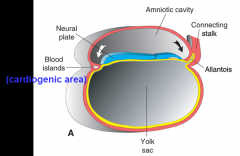
the cephalic central portion of the horseshoe-shaped plexus, in front of the buccopharyngeal membrane
|
|
|
The portion of intraembryonic coelom located over the cardiogenic area will develop into what?
|
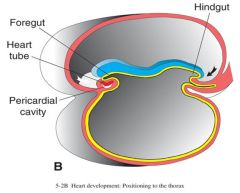
the pericardial cavity
|
|
|
The ________ develop bilaterally parallel & close to the midline, they vessels later connect w/ the arterial end of the heart tube
|
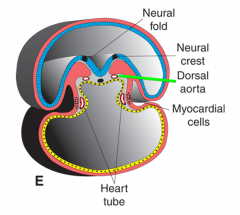
dorsal aortae
|
|
|
Lateral folding of the trilaminar germ disc brings together the 2 lateral endothelial tubes, where they fuse, forming what?
|
a single endocardial HEART TUBE
|
|
|
Mesoderm adjacent to heart tube thickens and forms what?
|
the epimyocardial mantle
|
|
|
The epimyocardial mantle is initially seperated from the endothelial tube by what?
|
cardiac jelly
|
|
|
The endothelial tube is invaded by cells from the __________, after being seperated from the epimyocardial mantle
|
endothelium
|
|
|
The wall of the heart tube develops into what 3 layers?
describe each |
endocardium- lines inner chambers
myocardium- muscular middle layer, forms most of wall thickness epicardium-(visceral pericardium) covers outside |
|
|
The intrapericardial part of the heart tube will become the future ______________
|
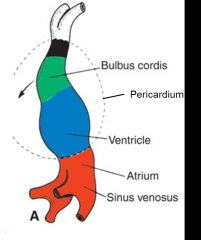
bulboventricular region
|
|
|
Local swellings, that will develop into projecting structures, appear on the heart tube. What pre-structure swelling are present starting from the venous end to the arterial end?
|

Venous End--->
> Sinus venosus (paired) > Atrium > Ventricle > Bulbus cordis ---> Aterial End |
|
|
The proximal 1/3 of the bulbus cordis will contribute to the ___________
The middle portion, conus cordis, will form outflow tracts for the __________ The distal 1/3 (truncus arteriosus, will form the proximal portions of the _____ & _______ |

proximal 1/3- right ventricle
middle (conus cordis)- outflow tracts of ventricles distal 1/3 (truncus arteriosus)- aorta & pulmonary trunk |
|
|
As the initially straight heart tube continues to bend, the cephalic portion bends ____________________
while the caudal portion shifts __________________ what does this create by day 28? |
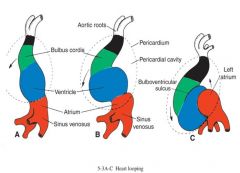
cephalic bends ventrally caudally & to right
caudal shifts dorsocranially & to left creates cardiac loop |
|
|
If the heart tube loops to the left instead of right, the heart will be located on the (right/left) side of thorax.
What is this called? |
right side of thorax = dextrocardia
|
|
|
Dextrocardia may coincide w/ a complete reversal of asymmetry in all organs, what is this called?
|
situs inversus
|
|
|
What is the truncoconal portion of the heart tube?
How does its position change during development? |
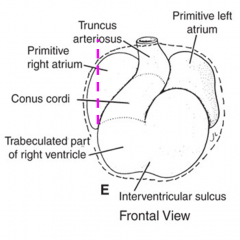
truncus arteriosis + conus cordis = truncoconal portion
Shifts from R side of pericardial cavity to more medially, ends up btwn dilatations of the atrium |
|
|
During the 4th week of development, the _____________ consists of a transverse portion & R & L sinus horns
|
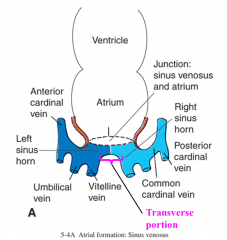
sinus venosus
|
|
|
Each sinus horn is receiving what 3 veins?
|
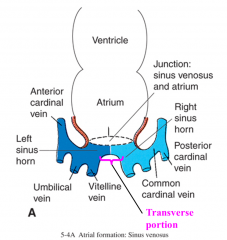
vitelline, umbillical, & common cardinal veins
|
|
|
As the communication btwn sinus venosus & atrium shifts right, what happens to the sinus horns and their veins?
|
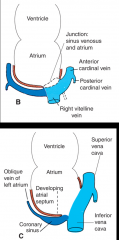
-left vitelline & common cardinal veins dissappear
-left sinus horn shrinks & becomes oblique vein of left atrium & coronary sinus |
|
|
The coronary sinus drains blood from where?
|
from cardiac veins
|
|
|
In contrast, the right sinus horn enlarges & is incorporated into what?
What does it become? |
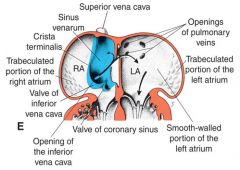
the right atrium
sinus venarum, smooth walled part of atrium |
|
|
The original R atrium form the rough walled part of the adult R atrium containing what?
|
pectinate muscles
|
|
|
The smooth (sinus venarum) & rough part of the atrium wall are seperated by what?
|
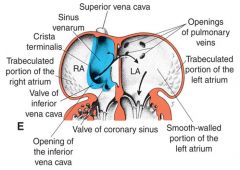
crista terminalis
|
|
|
Septum formation w/i common atrium begins with the formation of ____________, which grows from the roof toward endocardial cushions in the atrioventricular canal.
|
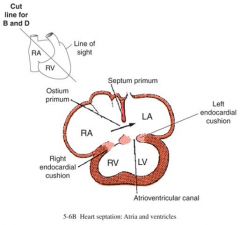
septum primum
(sickle-shaped) |
|
|
The ________ is the temporary opening btwn the septum primum & endocardial cushions
|

ostium primum
(btwn future R & L atrium) |
|
|
What appear in the septum primum before the ostium primum is closed?
What do they do? |
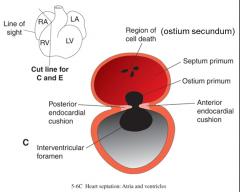
ostium secundum (perforations)
maintain blood flow from the R to L primitive atrium |
|
|
What is the septum secundum?
|
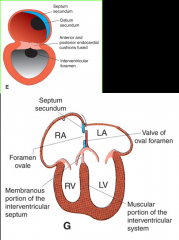
2nd crescent-shaped fold that appears to the R of the septum primium
|
|
|
The septum secundum never completely partitions the atrium, leaving what opening?
|
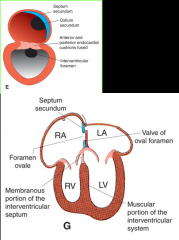
foramen ovale
|
|
|
The upper part of the septum primum degenerates and the lower part forms what?
|

valve of the foramen ovale
|
|
|
Until the fusion of the valve of the foramen ovale with the septum secundum at birth, blood flows from the ___________ to the _________ through the foramen ovale
|

from the R atrium to the L atrium
|
|
|
A probe patency of the foramen ovale persists in 25% of people, what is this?
|
failure of the foramen ovale to close
|
|
|
The R & L atria enlarge by incorporating other structures. What do each side incorporate?
|

R atrium- left sinus horn (sinus venarum)
L atrium- pulmonary vein & its (4?) tributaries |
|
|
Heat defects may be due to 3 different factors, what are they?
|
genetic: chromosomal abnormalities (Turners) of gene mutations
environmental: rubella virus multifactorial: combination |
|
|
Atrial septal defects are common and include ostium secundum defects. What are the causes and effects of ostium secundum defects?
|
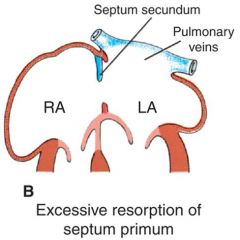
caused by: excessive resorption of septum primum or inadequate development of septum secundum
effects: significant Left-to-right shunting of blood may occur due to higher pressure on left side |
|
|
Another atrial septal defect, a patent foramen ovale, causes what?
|
if large enough, may permit left to right shunting of blood
|
|
|
Another atrial septal defect, closure of the foramen ovale during fetal life, results in what?
|
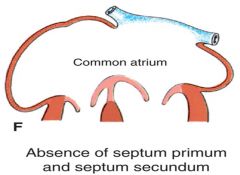
hypertrophy of the R side of hear (atrium & ventricle)
underdeveloped L side = left cardiac hypoplasia =death shortly after birth |
|
|
Complete absence of the atrial septum results in what?
|
common atrium (cor trilocular biventriculare)
= only 1 atrium, causes many problems |
|
|
What is the atrioventricular canal?
What are the two mesenchymal outgrowth from the canal? |
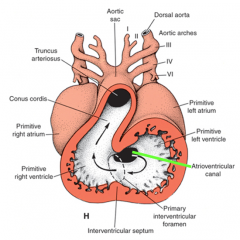
the junction btwn the original common atrium & L ventricle
endocardial cushions, develop at superior and inferior canal borders |
|
|
The superior & inferior cushion fuse, dividing the atrioventricular (AV) canal into 2 canals, providing what?
|
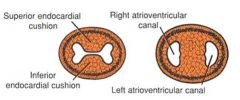
separate openings between each atria and its corresponding ventricle (atrioventricular orifice)
|
|
|
The right (____________) & left (_______/________) AV valves form when blood flow hollows & thins mesenchymal tissue on their ventricular surface,
|
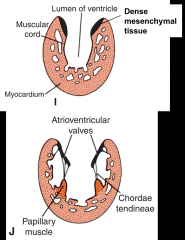
right- tricuspid valve
left- bicuspid/mitral |
|
|
The valve cusps are connected by _______ to papillary muscles
|
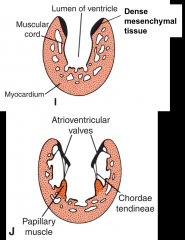
chordae tendinae
|
|
|
Septum formation in the conus cordis & truncus arteriosus occurs when.................
|
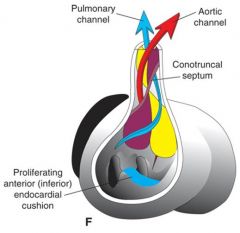
conotruncal (endocardial) cushions spiral 180 degrees as they grow toward each other and fuse
|
|
|
The conotruncual cushions develop from what?
They fuse to form what? |
migrating neural crest cells
aorticopulmonary septum |
|
|
what does the aorticopulmonary septum separate?
|
aortic & pulmonary channels
|
|
|
The inferior part of the aorticopulmonary septum fuses w/ an outgrowth from the inferior endocardial cushion to form what?
|
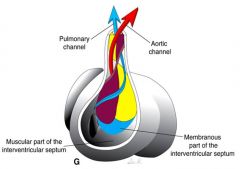
forms membranous portion of the interventricular septum
|
|
|
The muscular interventricular septum closes what?
|
the interventricular foramen
|
|
|
Ventricular septal defects, the most frequent isolated cardiac malformations, often involve what?
|

the membranous portion of the interventricular septum
***small VSDs may close spontaneously |
|
|
*Unequal division of the truncus arteriosus may result in tetralogy of Fallot, what does this consist of?
|
-pulmonary stenosis
-right ventricular hypertrophy -ventricular septal defect -overriding aorta |
|
|
Tetralogy of Fallot results in what?
|
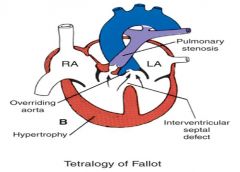
a right-to-left shunting of blood w/ cyanosis near time of birth due to poorly oxygenated blood in arterial circulation
|
|
|
How can tetralogy of fallow be distinguished on an X-ray
|
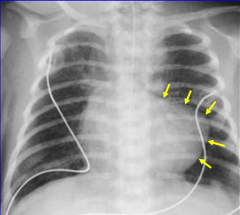
characteristic boot shaped heart
|
|
|
Failur of the aorticopulmonary septum to spiral as it descends may result in what?
This condition is incompatible w/ postnatal survival unless what? |
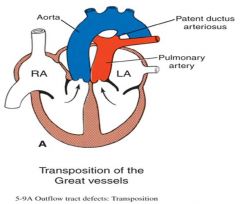
transposition of the great arteries =
-aorta rising from R ventricle & pulmonary trunk from L ventricle -->CYANOSIS unless accompanied by shunt, to allow oxygenated blood into aorta |
|
|
The developing heart tube bulges into the pericardial cavity & is suspended by _______________,
which subsequently disappears at future site of the _______________________ |
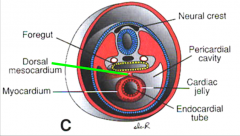
dorsal mesocardium
transverse pericardial sinus |
|
|
The dorsal mesocardium disappear & the heart tube is suspended by it's arterial & venous ends. These ends become seperated by what when the heart tube folds?
|
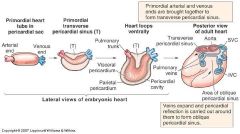
seperated by transverse pericardial sinus
|
|
|
The ______________________ is formed by pericardial reflections at the venous end of the heart
|
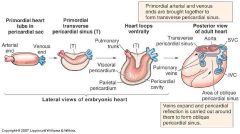
oblique pericardial sinus
|
|
|
What heart defects are associated with the following disorders?
Down's syndrome Turner's syndrome 22q11 syndrome Congenital Rubella Newborns of Diabetic mothers |
Down's syndrome- ASD
Turner's syndrome- coarctation of aorta 22q11 syndrome- truncus arteriosus Congenital Rubella- PDA Newborns of Diabetic mothers- transposition of great vessels |

